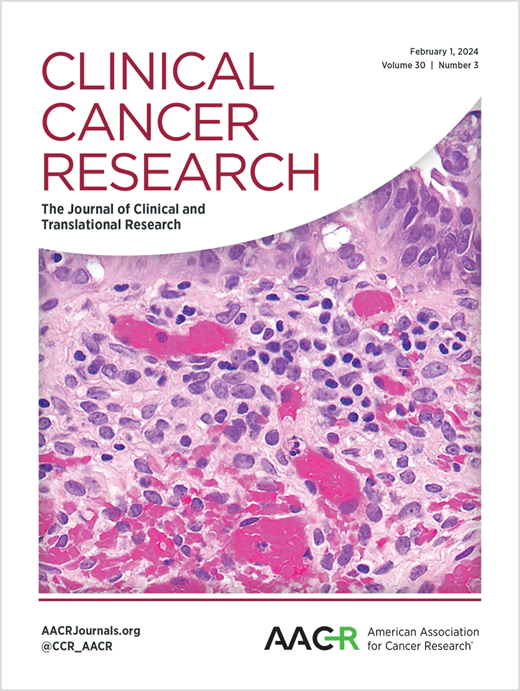染色体外MYC类似物的扩增形成小细胞肺癌免疫抑制肿瘤微环境
IF 10
1区 医学
Q1 ONCOLOGY
引用次数: 0
摘要
目的:免疫疗法在小细胞肺癌(SCLC)中已被证明是有希望的,但某些患者的获益有限,这突出了对免疫抑制生物标志物的需求。染色体外环状DNA (ecDNA)促进MYC类似物(MYC, MYCN和MYCL)的扩增,驱动SCLC的交叉耐药。在这里,我们的目的是研究ecdna介导的myc -旁系扩增(ecMYC+)是否代表SCLC的免疫抑制特征。实验设计:从公共数据库和石蜡包埋样品中检索大量RNA测序数据。利用免疫组织化学和荧光原位杂交技术鉴定myc -旁系物的过表达和扩增。肿瘤免疫微环境(TIME)的空间分布采用成像细胞术和多重免疫组化技术。采用实时聚合酶链反应检测myc -相似物的拷贝数。对SCLC细胞系进行rna测序和流式细胞术检测。结果:SCLC中ecdna的平均拷贝数和ecMYC+细胞系的出现频率高于其他谱系(SCLC为22/47,其他谱系为15/282)。在ecMYC+ SCLC中,多种免疫相关通路下调,而核苷酸代谢过程上调。抑制核苷酸代谢诱导ecDNA消除,同时激活抗原递呈途径。在切除的treatment-naïve SCLC样本中检测到高度分散的myc相似扩增。通过对来自24个病理区域的103341个细胞的解析,我们观察到在ecMYC+样本中MKI67、VEGFA、FAP和FOXP3的表达增加,T细胞浸润减少。此外,ecMYC+样品显示以Ki67+肿瘤为主的细胞邻域升高,与免疫细胞的空间相互作用减少。结论:染色体外扩增的myc类似物形成抑制时间,识别潜在的免疫治疗耐药患者亚群。本文章由计算机程序翻译,如有差异,请以英文原文为准。
Amplification of extrachromosomal MYC paralogs shapes immunosuppressive tumor microenvironment in small cell lung cancer
Purpose: Immunotherapy has demonstrated promise in small cell lung cancer (SCLC), but certain patients encounter limited benefits, highlighting the need for immunosuppressive biomarkers. Extrachromosomal circular DNA (ecDNA) promotes amplification of MYC-paralogs (MYC, MYCN and MYCL), driving cross-resistance in SCLC. Here, we aim to investigate whether ecDNA-mediated MYC-paralogs amplification (ecMYC+) represents immunosuppressive features in SCLC. Experimental Design: Bulk RNA sequencing data were retrieved from public database and paraffin-embedded samples. The overexpression and amplification of MYC-paralogs were identified using immunohistochemistry and fluorescence in situ hybridization. Imaging mass cytometry and multiplex immunohistochemistry were used to characterize spatial distribution of tumor immune microenvironment (TIME). The copy number of MYC-paralogs was investigated using real-time polymerase chain reaction. RNA-sequencing and flow cytometry were performed in SCLC cell lines. Results: The mean copy number of ecDNAs and the frequency of ecMYC+ cell lines were higher in SCLC than that in the other lineages (SCLC 22/47 vs others 15/282). In ecMYC+ SCLC, multiple immune-related pathways were downregulated while nucleotide metabolism processes were upregulated. Inhibition of nucleotide metabolism induced ecDNA elimination, along with activated antigen presenting pathways. Highly dispersed MYC-paralogs amplifications were detected in resected treatment-naïve SCLC samples. Through the resolution of 103,341 cells from 24 pathological regions, we observed higher expression of MKI67, VEGFA, FAP and FOXP3 and reduced T cell infiltration in ecMYC+ samples. Moreover, ecMYC+ samples exhibited elevated cellular neighborhoods dominated by Ki67+ tumors, with reduced spatial interaction with immune cells. Conclusions: Extrachromosomal amplification of MYC-paralogs shapes suppressive TIME, identifying potential subgroup of immunotherapy resistant patients.
求助全文
通过发布文献求助,成功后即可免费获取论文全文。
去求助
来源期刊

Clinical Cancer Research
医学-肿瘤学
CiteScore
20.10
自引率
1.70%
发文量
1207
审稿时长
2.1 months
期刊介绍:
Clinical Cancer Research is a journal focusing on groundbreaking research in cancer, specifically in the areas where the laboratory and the clinic intersect. Our primary interest lies in clinical trials that investigate novel treatments, accompanied by research on pharmacology, molecular alterations, and biomarkers that can predict response or resistance to these treatments. Furthermore, we prioritize laboratory and animal studies that explore new drugs and targeted agents with the potential to advance to clinical trials. We also encourage research on targetable mechanisms of cancer development, progression, and metastasis.
 求助内容:
求助内容: 应助结果提醒方式:
应助结果提醒方式:


